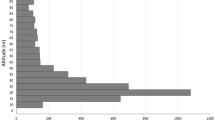Abstract
The phenomenon of wildlife mortality at wind turbine installations has been generating increasing concern, both for the continued development of the wind industry and for local ecology. While an increase in aerial insectivore activity in the vicinity resulting from insect attraction to turbines remains a strong possibility, little research exists on the possible causes for such events. In this paper, the relative attraction of a selection of specific turbine colours and other hues is assessed in order to determine if turbine paint colour could be influencing insect numbers at these installations. The common turbine colours ‘pure white’ (RAL 9010) and ‘light grey’ (RAL 7035) were among those found to attract significantly more insects than other colours tested, suggesting colour may well have a role to play in potential mitigation.






Similar content being viewed by others
References
Ahlén I (2004) Wind turbines and bats—a pilot study. Report prepared for the Swedish National Energy Administration [www document]. <http://www.eurobats.org/documents/pdf/AC9/Doc_AC9_14_Wind_turbines_pilot_study.pdf> (Accessed 01 October 2009)
Arnett EB, Brown WK, Erickson WP, Fiedler JK, Hamilton BL, Henry TH, Jain A, Johnson GD, Kerns J, Koford RR, Nicholson CP, O’Connell TJ, Piorkowski MD, Tankersley RD Jr (2008) Patterns of bat fatalities at wind energy facilities in North America. J Wildl Manage 72:61–78
Bracknell Forest Borough Council (2007) Wind Turbine Colour Planning Permission [www document]. <http://www.bracknell-forest.gov.uk> (accessed 01 October 2009)
Briscoe AD, Chittka L (2001) The evolution of color vision in insects. Annu Rev Entomol 46:471–510
Craig CL, Bernard GD (1990) Insect attraction to ultraviolet-reflecting spider webs and web decorations. Ecology 71:616–623
Cryan PM (2008) Mating behavior as a possible cause of bat fatalities at wind turbines. J Wildl Manage 72:845–849
Danish Wind Industry Association (DWIA) (2003) Wind Turbines and the Environment: Landscape [www document]. <http://www.windpower.org> (accessed 14 October 2009)
Department of Trade and Industry (DTI) (2005) Guidance on the assessment of the impact of offshore wind farms: Seascape and visual impact report. URN 05/1583, HMSO, London
Dürr T, Bach L (2004) Bat deaths and wind turbines—a review of current knowledge, and of the information available in the database for Germany. Bremer Beitr Naturkunde Naturschutz 7:253–264
Griffin DR, Webster FA, Michael CR (1960) The echolocation of flying insects by bats. Anim Behav 8:141–154
Horn JW, Arnett EB, Kunz TH (2008) Behavioural responses of bats to operating wind turbines. J Wildl Manage 72(123):132
Johnson G, Kunz T (2004) Bat ecology related to wind development and lessons learned about impacts on bats from wind development. Proceedings of the Wind Energy and Bird/Bats Workshop, pp 46–56
Kerns J, Kerlinger P (2004) A study of bird and bat collision fatalities at the Mountaineer Wind Energy Centre, Tucker County, West Virginia: Annual report for 2003. Report prepared for FPL Energy and MWEC Technical Review Committee [www document]. <http://www.wvhighlands.org/Birds/MountaineerFinalAvianRpt-%203-15-04PKJK.pdf> (accessed 17 November 2009)
Kevan PG (1983) Floral colors through the insect eye: what they are and what they mean. In: Jones CE, Little RJ (eds) Handbook of experimental pollination biology. Van Nostrand, New York, pp 3–25, Scientific and Academic Additions
Lunau K, Maier EJ (1995) Innate colour preferences of flower visitors. J Comp Physiol A 117:1–19
McCall C, Primack RB (1992) Influence of flower characteristics, weather, time of day, and season on insect visitation rates in three plant communities. Am J Bot 79:434–442
Nicholls B, Racey PA (2007) Bats avoid radar installations: could electromagnetic fields deter bats from colliding with wind turbines? PloS One 2:1–7
Piorkowski MD (2006) Breeding bird habitat use and turbine collisions of birds and bats located at a wind farm in Oklahoma mixed-grass prairie. MSc thesis, Oklahoma State University
Prokopy RJ, Boller EF (1971) Response of European cherry fruit flies to coloured rectangles. J Econ Entomol 64:1444–1447
Prokopy RJ, Owens ED (1983) Visual detection of plants by herbivorous insects. Annu Rev Entomol 28:337–364
Rodrigues L, Bach L, Biraschi L, Dubourg-Savage MJ, Goodwin J, Harbusch C, Hutson T, Invanova T, Lutsar L, Parsons K (2006) Wind turbines and bats: guidelines for the planning process and impact assessments. Eurobats Resolution 5.6, pp 51–73
Thorsteinson AJ (1958) The orientation of horse flies and deer flies (Tabunidae, Diptera): I. The attraction of heat to Tabanids. Entomol Exp Appl 1:191–196
Vestas Wind Systems (2006) General Specification for Wind Turbine V90-3.0 MW VCRS [www document]. <http://www.gov.pe.ca/photos/sites/envengfor/file/950010R1_V90-GeneralSpecification.pdf> (accessed 16 October 2009)
Wickramasinghe LP, Harris S, Jones G, Vaughan N (2003) Bat activity and species richness on organic and conventional farms: impact of agricultural intensification. J Appl Ecol 40:984–993
Willmer PG (1983) Thermal constraints on activity patterns in nectar-feeding insects. Ecol Entomol 8:455–469
Young DP, Erickson WP, Strickland MD, Good RE, Sernka KJ (2000) Comparison of avian responses to UV-light-reflective paint on wind turbines. Report prepared for the NREL [www document]. <http://www.nrel.gov/docs/fy03osti/32840.pdf> (accessed 16 October 2009)
Acknowledgements
The authors would like to thank Brocks Hill Environment Centre and Oadby and Wigston Borough Council for granting permission to use the study area. We are also grateful to Dr. S. Williams-Worrall of the Department of Chemistry, Loughborough University, for assistance with spectrometer measurements.
Author information
Authors and Affiliations
Corresponding author
Additional information
Communicated by C. Gortázar
Rights and permissions
About this article
Cite this article
Long, C.V., Flint, J.A. & Lepper, P.A. Insect attraction to wind turbines: does colour play a role?. Eur J Wildl Res 57, 323–331 (2011). https://doi.org/10.1007/s10344-010-0432-7
Received:
Revised:
Accepted:
Published:
Issue Date:
DOI: https://doi.org/10.1007/s10344-010-0432-7




